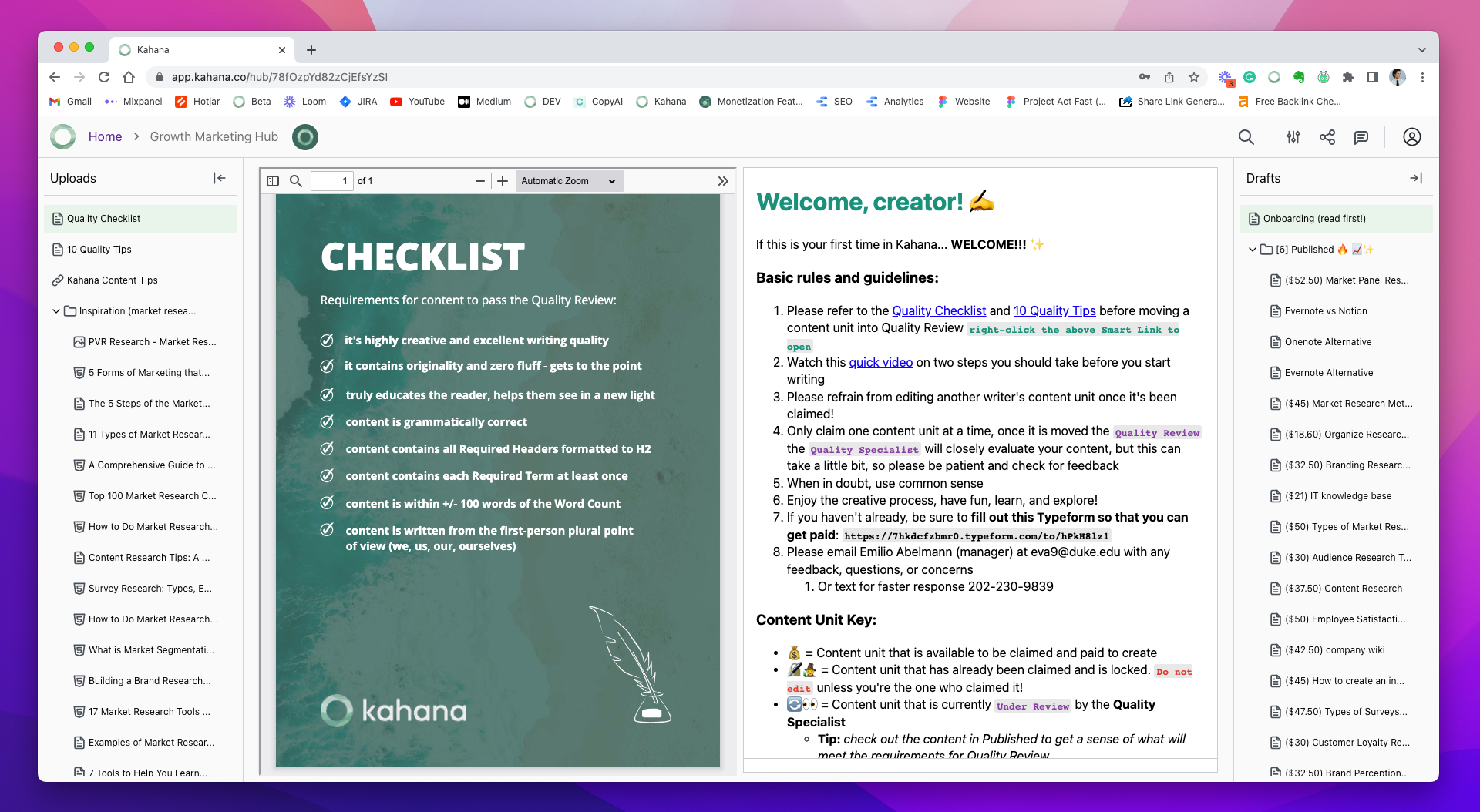Content Research: Tools, Tips, & Free Template

Topics covered ✅
- Content research tool
- Content research example
- Content researcher
- Content research process
- BuzzSumo content research
- Content research for social media
When you're creating content for your brand, it can be hard not to feel like you're swimming through the ocean with no direction and no goal.
You might have a vague idea of what you want your audience to do, but how do you actually get them there?
It's time to stop swimming and start rowing!
In this article, we’ll share our favorite content research tips for making the most of your products.
1. First Off, Why Research Pieces of Content?
Content research is the process of understanding what content your audience is already consuming and how they're consuming it.
It's about understanding what kind of content people are looking for, and how you can create that content in a way that will resonate with them.
The content research process is a crucial part of the content marketing strategy.
It helps you determine what kind of content to create, how much time and money to invest in it, and what keywords people are searching for that could lead them to your website.
This process can be a bit of a mystery.
If you've ever tried to write a blog post or an email and found yourself wondering where to start, you're not alone.
Content creation is one of the most challenging aspects of any marketing plan—and it's also one of the most important.
But don't worry!
We're here to help you figure out how to do content research so that you can create pieces that are successful, attention-grabbing, and memorable.
Once you've got an idea of what kind of content is needed, start looking for keywords that are related to that content.
You can use Google Keyword Planner or another keyword tool to find these terms. For example, BuzzSumo’s content research platform scans billions of articles and social posts to generate insights.
Lastly, developing outlines and using search engine optimization will be the final trick to creating a great content research analysis.

Claim My Free Content Research Template
This hub serves as a free template to help you get started and includes free tools, tips, and examples for content research.
2. Target Audience and How It Relates to Creating Exceptional Content Ideas
First things first: who is your target audience?
Your audience is made up of real people who have needs and desires for which they'll be searching online.
You need to know what those needs are so that when you create content, it speaks directly to them—and only them.
This will help you understand what kind of information they need and how you can provide it in a way that will be most useful for them.
You can use different types of surveys for research or polls, interviews, audience research tools, or even just ask yourself: who would I like to give this information to?
Figuring out who this content will be meant for is the first step to success.
- Who are the people who need what you have?
- What problems will they have if they don't get it?
- How can writing help them achieve their goals?
The more specific you can be about these questions, the better off you'll be when it comes time to start writing.
Getting solid answers to all these questions can greatly kick-start the research process and give you a great outline of what to look for.
Once you have an idea of who your audience is, then it's time to start collecting keyword ideas for your content strategy!
3. Keywords and Using Google to Create Traffic To Your Page
Once you know who your audience is and what their problems are, it's time to think about how others might search for their needs online.
Keyword research can help you understand how people are looking for solutions similar to yours so that when they come across your site, they'll know exactly what they're looking at.
When it comes to content marketing tools, one of the most important elements is creating a high-quality, useful, and compelling piece of content.
This can be done through a number of different methods, but one of the easiest ways to do so is by using keyword research and analysis.
The key to a successful content strategy lies within the keywords and phrases people search for. If you tailor your content to those words, you'll be able to reach a larger audience than ever before.
Keyword research is the process of finding out what people are searching for on Google or other search engines.
It involves analyzing search terms and using those results as inspiration for topics for blog posts, articles, or videos.
The goal of keyword research is to help you create content that answers questions people have—and get them to click through from Google search results.
Keyword research can help you discover what terms and phrases your audience is using when they search for information online.
You can then use this information as inspiration when writing your own blog posts, social media updates, or other forms of content. Here's how to find those keywords:
Step 1. Begin with the basics
Start with some basic keyword ideas.
What are some terms that might describe your business?
Is there an issue that your customers have been struggling with lately?
If so, what are they searching for online?
Step 2. Use Google Trends or Keyword Planner (or both)
Do some research on these topics by using Google Trends or Keyword Planner (both free).
These tools will show you how many people are searching for each term over time, as well as related searches that you may want to consider; including in your content analysis.
Step 3. Don’t forget SEMrush and Ahrefs
Use tools like SEMrush and Ahrefs to see which sites rank well for these terms, so you know where people go when they're looking for information about what you offer!
There are many tools out there that can help with this step—we like SEMRush and Ahrefs because they're free.
You may want to use different tools at different stages of the process though—for example, SEMRush can be useful while brainstorming keywords, but not so much once you've narrowed down your list based on search volume or competition.
We also recommend gathering keyword ideas from Google Adwords Keyword Planner or Ahrefs (both free tools).
You can use these sites to find keywords related to your business; then plug those keywords into Google Trends to gauge how many people are actually searching for them right now—and how often they're being searched over time.
Another important part of this stage is determining which pieces of content will be most successful based on your keyword research and target audience analysis—and making sure those relate to your company’s values and mission.
4. The Secret Weapon. . . an Outline!
The next step is taking all your information and putting it together; into a strategy for each piece of content on your site.
Identifying different types of content will help you reach these goals.
In other words, what kind of information would someone looking for this topic want to see?
Developing an outline for each piece of content based on strategy and user intent is the best solution for how to organize research and information you've collected in steps 1 and 2.
Google is your best friend in this scenario.
A quick search can expose you to so many useful outlines and other organizational strategies that are sure to be beneficial for your research process.
5. Search Engine Optimization and Its Purpose
If you're looking for a new way to approach content marketing, it's time to start thinking like SEO.
SEO stands for "search engine optimization" and it's a way of writing and publishing content that will help your website rank higher in search engines.
The idea is that if people are searching for something specific, they'll find your website when they look because it's the best match.
Here's how you can start using SEO strategies in your own content strategy:
- Think about your target audience. What words do they use? What questions do they ask? What kinds of things are they looking for? This will help you conduct keyword research for what you should be targeting with your content—and which ones aren't worth pursuing (because no one is searching for them).
- Create pieces of content that answer questions or solve problems for your audience. Make sure each piece contains at least one keyword related to what people are searching for on Google or Bing (or any other search engine). Then link those keywords back to pages on your website so people can find them easily!
- Make sure your website has an easy-to-follow navigation system so readers can easily find the information they need without having to click through multiple pages before getting there.
When you go onto Google and type in your company to the search bar, you want to be the first name that people see.
SEO will guarantee that.
6. The Final Game Plan for Making Your Content Research Work
Once you know what kind of content people want, you can start creating it!
Create pieces that address their pain points and help them solve the challenges they face.
Content success depends on knowing what your audience wants and providing it!
When our company got around to researching, we made a lot of mistakes—the same ones that most people make.
But now, we've learned and grown from our mistakes.
We hope you learned a thing or two that helped improve or influence your own content research process.
Now no more dilly-dallying, let's get researching!

Talk with a Kahana representative
Fill out your information and a Kahana team representative will reach out to you. Have a simple question? Search our library of articles
